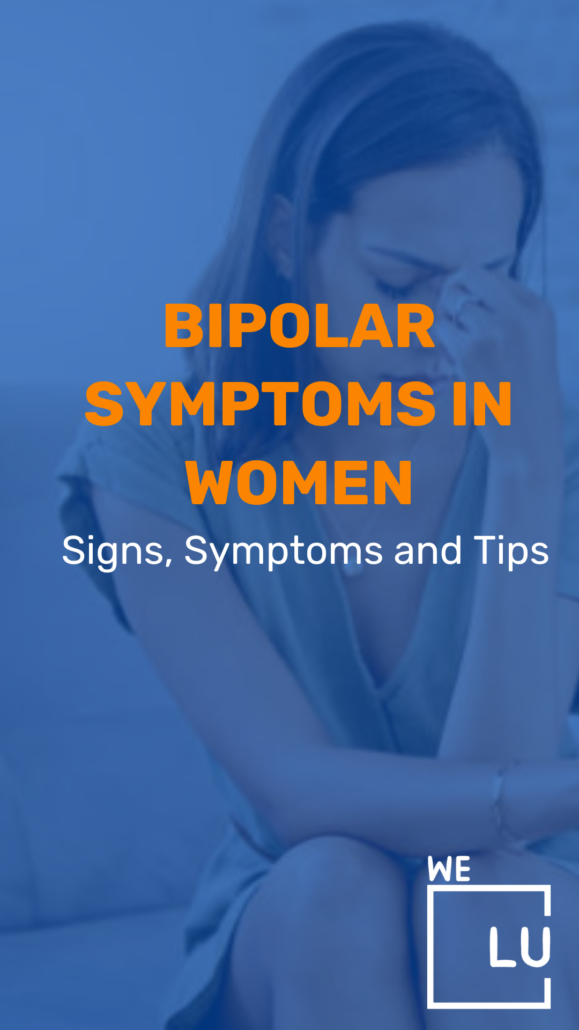What is Bipolar Disorder?
It is a mental disease that causes abrupt mood changes, from emotional highs (mania or hypomania) to lows (depression). People go through depressive stages where they often feel sad or hopeless and lose interest in or pleasure from most things. On the other hand, when a person’s mood changes to mania or hypomania (a lesser form of focus), they may feel happy, have more energy, or be more irritable.
These mood changes can significantly affect how you sleep, your energy, your daily tasks, your ability to make decisions, your behavior, and your ability to think clearly.
Bipolar Symptoms in Women
Bipolar disease is a sickness that people have their whole lives. But if you stick to a treatment plan, you can control your mood dips and other symptoms. Psychotherapy (also called counseling) and medications are often used to help bipolar disorder.
Bipolar disease can happen to both men and women, but there are some essential differences between the two. In this case, signs of bipolar illness may appear later in women than men. In addition, depression episodes in women can last longer than in men.
Also, women are more likely than men to have other health problems that can happen simultaneously as bipolar disorder. Periods, menstruation, and menopause can change the signs of bipolar disorder and how it is handled.
Doctors use the Diagnostic and Statistical Manual of Mental Disorders, Fifth Edition, Text Revision (DSM-5-TR) to help them figure out what’s wrong with a person’s mental health and how to treat it.
The DSM-5-TR says that someone has to have had at least one episode of mania or hypomania, which is a high mood, to be diagnosed with bipolar disorder. It’s important to remember that hypomania is not as bad as full-blown mania.
Symptoms of mania or hypomania, irrespective of gender, encompass:
- Sensations of heightened elation.
- Restlessness or irritability.
- Increased energy levels.
- Elevated self-esteem.
- Belief in one’s limitless capabilities.
- Reduced need for sleep and food.
- Rapid and excessive talking.
- Racing thoughts or quick changes of focus.
- Easy distractibility.
- Engaging in riskier behaviors, such as excessive spending or dangerous activities.
Researchers have not identified significant differences in how mania symptoms manifest in females compared to males.
Many individuals with bipolar disorder also encounter at least one depressive episode, often of severe intensity. A 2015 review of previous studies shows that 75% of females and 67% of males first exhibit depressive symptoms, signifying a depressive episode as the initial indicator of bipolar disorder in many cases.
Symptoms of depression may encompass:
- Persistent feelings of sadness or hopelessness.
- Sluggishness and slowed speech.
- Restlessness.
- Changes in appetite and body weight.
- Loss of interest in once-enjoyable activities.
- A sense of emptiness and an inability to express oneself.
- A pervasive sense of hopelessness.
- Difficulty concentrating.
- Sleep disturbances.
- Thoughts of or conversations about death or suicide.
In severe cases of bipolar disorder, individuals may experience bipolar psychosis, characterized by delusions, paranoia, or hallucinations. These symptoms may manifest during episodes of acute mania or depression.
Signs of Bipolar Disorder in Women
Here are some critical signs of bipolar disorder in women:
- Mood Swings: Women with bipolar disorder often feel extreme mood swings, including manic highs and lows.
- Increased Energy and Activity: Manic episodes can lead to heightened energy levels and excessive activities.
- Irritability: Women may exhibit increased irritability during manic or depressive episodes, affecting relationships.
- Sleep Pattern Changes: Disrupted sleep patterns are expected, with reduced sleep during mania and insomnia or excessive sleep during depression.
- Impulsive Behavior: Impulsivity can occur, such as reckless spending and substance use.
- Difficulty Concentrating: Bipolar disorder can make focusing, deciding, or remembering challenging.
- Appetite Changes: Appetite may fluctuate, with reduced food intake during mania and overeating during depression.
- Social Withdrawal: Depressive episodes can lead to withdrawal from social activities and interests.
- Physical Symptoms: Physical symptoms like headaches and body aches may accompany depressive phases.
- Menstrual Cycle Impact: Some women notice mood fluctuations related to their menstrual cycle.

Skip To:
Learn More:
- Is Bipolar a Personality Disorder? BPD vs. Bipolar
- 4 Common Bipolar Symptoms in Men, Signs, Tips, & Treatment
- Bipolar Disorder Medication, 8 Side Effects, and Effective Treatment
- Bipolar Disorder Therapies. Different Types of Effective Therapy for Bipolar Disorder
- Understanding How a Bipolar Person Thinks. What Does Bipolar Feel Like? Signs and Symptoms of Bipolar Disorder
- ADHD and Bipolar Disorder Guide. ADHD Vs Bipolar. Bipolar and ADHD Symptoms. Bipolar Vs ADHD Diagnosis. ADHD Bipolar Treatments.
- Understanding Rapid Cycling Bipolar Disorder. Symptoms and Effective Treatments.
- Lithium for Bipolar Disorder, Understanding Side Effects and Potential Risks
- Is Bipolar Disorder Genetic? Understanding the Risks of Your Family History
Are you Bipolar?
If you suspect you have bipolar disorder or want to understand your mental health better, taking this self-assessment can be a valuable first step.
Get Help. Get Better. Get Your Life Back.
Searching for Accredited Dual Diagnosis Mental Health Centers Near You?
Even if therapy failed previously, or are in the middle of a difficult crisis, we stand ready to support you. Our trusted behavioral health specialists will not give up on you. When you feel ready or just want someone to speak to about counseling alternatives to change your life call us. Even if we cannot assist you, we will lead you to wherever you can get support. There is no obligation. Call our hotline today.
FREE 24/7 Dual Diagnosis Mental Health Services HotlineHow Bipolar Symptoms in Women Can Be Overcome: Dr. Al’s Patient Recovery Story
Sarah’s Bipolar Disorder Recovery Story
It was a rough road for Sarah as she dealt with her bipolar illness. In her early twenties, she first experienced manic and depressive episodes. The emotional ups and downs that followed threw her life into chaos. Going through constant highs and lows hurt her job, relationships, and health.
People with bipolar illness, like Sarah at first, often don’t want to get professional help. She was worried about the shame of having a mental health problem and the possible side effects of the medicine she was taking. But her breaking point came when she had a severe depressive episode that made her feel like there was no way out.
At this crucial point, Sarah talked to Dr. Al, a well-known psychiatrist specializing in bipolar illness. Sarah felt at ease when Dr. Al spoke to her kindly and understandingly. He carefully evaluated her state, considering the specific things she had been through and her symptoms.
Sarah’s treatment plan was comprehensive. It included both medicine and psychotherapy that were specially designed for her. Dr. Al stressed the importance of communicating openly and having Sarah choose her treatment. This team-based method gave Sarah the power to be involved in her recovery.
With Dr. Al’s help, Sarah learned over time what caused her mood swings and what signs to look out for. She learned healthy ways to deal with stress and keep from relapsing. She better understood her feelings and thought patterns through treatment, which made her stronger during the ups and downs.
While Sarah was getting better, she had some hurdles, but Dr. Al was there for her the whole time. By changing her treatment plan, they worked together to ensure she got the best care possible.
Sarah’s story shows that it is possible to get better from bipolar illness. She has started over in her work, taken care of her relationships, and made her life more fulfilling and balanced. With the right help, treatment, and resolve, Sarah’s story shows that the problems caused by bipolar symptoms can be solved.
Introducing Dr. Al: A Specialist in Addiction Studies and Mental Health Disorders.
With over 15 years of expertise in behavioral health, Dr. Al has dedicated his career to transforming lives. He, his team, plus the We Level Up treatment center network have successfully guided countless patients through the most daunting obstacles they have ever encountered. Join Dr. Al and We Level Up on a journey toward healing and triumph. Learn more about Dr. Al here.

Tips and Strategies for Managing your Bipolar Disorder
✅ Medication Consistency: Stick to your prescribed medications and routines. They play a vital role in mood stability.
✅ Routine & Sleep: Maintain a regular daily schedule, including quality sleep. It’s a powerful mood stabilizer.
✅ Identify Triggers: Recognize your mood triggers, like stress or lack of sleep, and develop strategies to cope effectively.
✅ Support Network: Build a strong support network. Friends, family, and mental health professionals can be your allies on this journey.
Remember, small steps can lead to significant progress. Stay committed, and take each day as it comes. You’ve got this!
Bipolar Disorder Facts
Bipolar Disorder
- Mood Episodes: Characterized by distinct episodes of mania/hypomania and depression.
- Duration: Mood episodes can last for days, weeks, or months.
- Triggers: Episodes can occur without external triggers, and mood shifts are often unrelated to specific events.
- Self-Image: Individuals typically have a stable sense of self and identity.
- Impulsivity: Impulsive behaviors may occur during manic episodes.
- Treatment: Mood-stabilizing medications are often prescribed, along with psychotherapy.
Types of bipolar disorder
There are several types of bipolar disorder, including:
- Bipolar I disorder: Characterized by manic episodes lasting at least seven days or severe manic symptoms requiring immediate hospitalization.
- Bipolar II disorder: Involves a pattern of depressive episodes and hypomanic episodes, but not full-blown mania.
- Cyclothymic disorder: Marked by numerous periods of hypomanic and depressive symptoms that last for at least two years (one year for children and adolescents).
Symptoms
The symptoms of bipolar disorder vary depending on the mood episode:
- Manic episodes: Elevated mood, increased energy, racing thoughts, impulsivity, decreased need for sleep, excessive talking, grandiosity, and risky behavior.
- Hypomanic episodes: Similar to manic episodes but with less severity and a shorter duration.
- Depressive episodes: Persistent sadness, loss of interest or pleasure in activities, changes in appetite and sleep patterns, fatigue, feelings of guilt or worthlessness, difficulty concentrating, and thoughts of death or suicide.
Impact on daily life
- Bipolar disorder can significantly impact various aspects of a person’s life, including relationships, work or school performance, and overall quality of life. However, with proper treatment and support, individuals with bipolar disorder can manage their symptoms effectively and lead fulfilling lives.
Understanding Bipolar Disorder PDF Download
Bipolar Disorder Statistics
Bipolar disorder is a complex mental health condition affecting millions worldwide. Characterized by alternating periods of intense mood swings, ranging from elevated states of mania to episodes of profound depression, bipolar disorder can significantly impact a person’s daily functioning, relationships, and overall quality of life.
- Prevalence: According to the World Health Organization (WHO), bipolar disorder affects approximately 2.4% of the global population. It occurs equally among men and women and can develop at any age, although the typical age of onset is late adolescence to early adulthood.
- Lifetime Risk: The National Institute of Mental Health (NIMH) estimates that about 4.4% of adults in the United States will experience bipolar disorder at some point.
- Comorbidity: Bipolar disorder often co-occurs with other mental health conditions. Studies show that approximately 60-70% of individuals with bipolar disorder have at least one comorbid psychiatric disorder, such as anxiety disorders, substance use disorders, or attention-deficit/hyperactivity disorder (ADHD).
2.4%
The global prevalence of bipolar disorder.
Source: CDC
25 years
Bipolar disorder typically emerges in late adolescence or early adulthood
Source: NIMH
3:1
BPD is more commonly diagnosed in females
Source: NIH

End the Emotional Pain. Get Your Life Back.
Feeling Depressed, Anxious or Struggling with Mental Health Illness? Get Safe Comfortable Mental Health Dual Diagnosis High-Quality Therapy From Counselors That Care. Begin Your Recovery Now.
Hotline (855) 940-6125